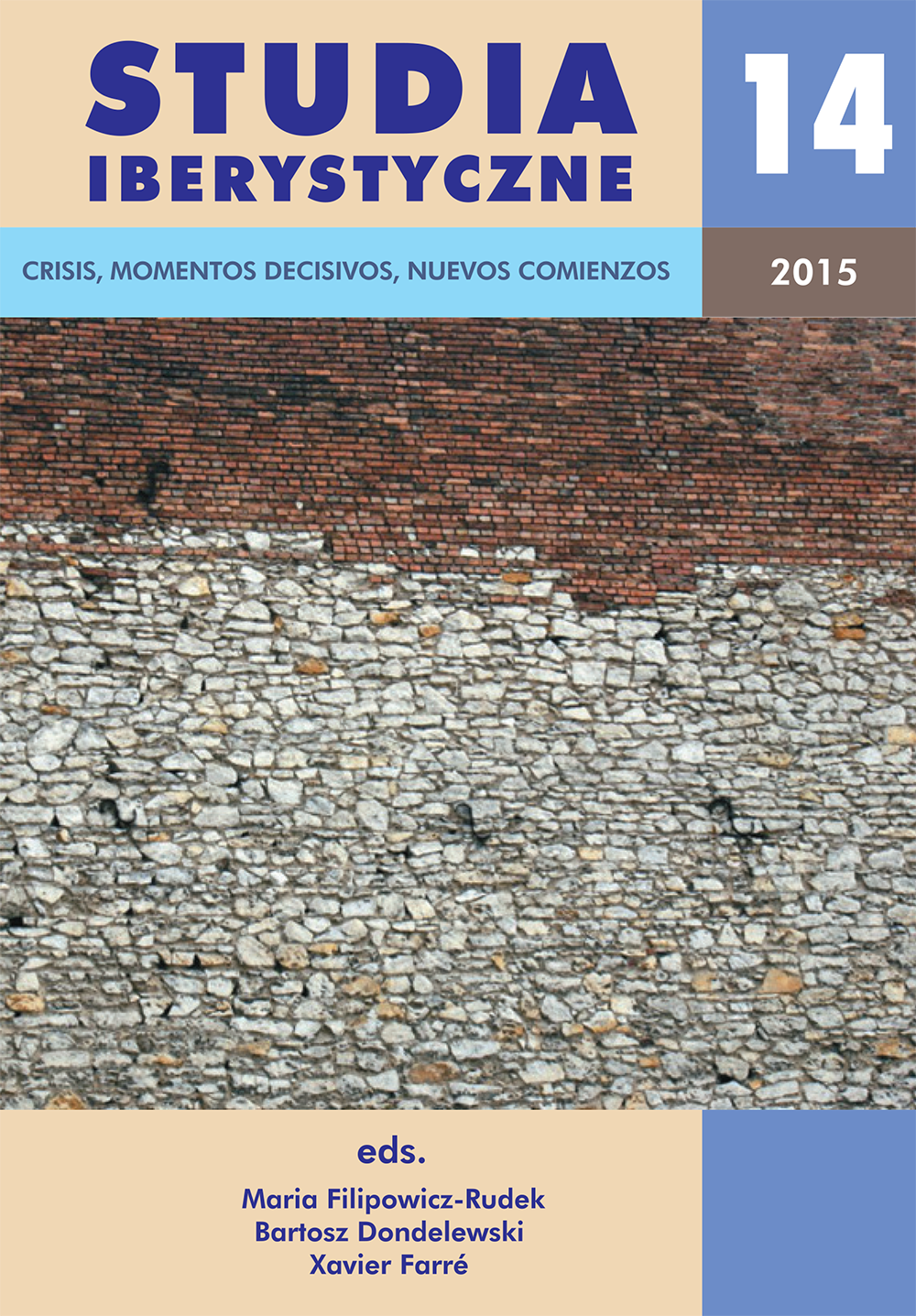Katalońska pamięć historyczna i kryzys hiszpańskiej państwowości: przyczynek
DOI:
https://doi.org/10.12797/SI.14.2015.14.06Palabras clave:
Crisis de la nación estado español, Ideología del independentismo catalán, identidad histórica catalana, caída de Barcelona, Diada NacionalResumen
La presente crisis de la identidad de la nación española está centrada en las aspiraciones del nacionalismo catalán para crear un estado soberano e independiente. Hay la percepción generalizada de que el nacionalismo catalán surge como una reacción a la crisis económica y a la distribución no igualitaria de la riqueza, o incluso como una especie de “traición” que cometen los partidarios de la postura nacionalista en contra del Estado. Mientras que desde el punto de vista catalán se invocan razones culturales para llegar a la independencia, así como también a la identidad nacional pasada por el tamiz de la mitologización construida a través de los acontecimientos históricos. El presente estudio pretende analizar la manera cómo la identidad catalana tiene la impronta de la memoria histórica en episodios tales como la Sublevación de Cataluña (Guerra de los Segadores, 1640-52), y el Sitio y la caída de Barcelona (11-09-1714), la proclamación de la República de Cataluña (1931) y la proclamación del Estado Catalán dentro de la República Federal española (1934).
Referencias
“1,8 milions de catalans reclamen votar amb una històrica V a Barcelona” (2014), [w:] El Punt Avui, 11 IX, [on line] http://www.elpuntavui.cat/article/3‑politica/17‑politica/776145‑la‑v‑la‑mobilitzacio‑mes‑gran‑deuropa‑una‑realitat.html?dema=1&tmpl=component&print=1&page= – 30.10.2015.
“Exhibición de fuerza independentista en la Via Lliure” (2015), [w:] El Periódico. Barcelona, 11 IX, [on line] http://www.elperiodico.com/es/noticias/politica/exhibicion‑fuerza‑independentista‑via‑lliure‑4500521 – 30.10.2015.
“Llegada del Gobierno de la Generalidad de Cataluña” (1936), [w:] La Vanguardia, 3 III, ss. 8‑12, [on line] http://hemeroteca.lavanguardia.com/preview/1936/03/03/pagina‑10/33123560/pdf.html – 28.09.2015.
“Manifestaciones del auditor de guerra” (1934), [w:] La Vanguardia, 20 X, s. 7, [on line] http://hemeroteca.lavanguardia.com/preview/1934/10/20/pagina‑7/33166157/pdf.html – 28.09.2015.
“Noves” (1886), [w:] Arch de Sant Martí, 8 IX, s. 872, [on line] http://mdc2.cbuc.cat/cdm/compoundobject/collection/archstmarti/id/8543/rec/185 – 04.11.2015.
Anguera , P. (2003), “El 11 de septiembre. Orígenes y consolidación de la Diada”, [w:] Ayer, 51, ss. 17‑38.
Anguera , P. (2008), L’onze de setembre: història de la Diada (1886‑1938), L’Abadia de Montserrat, Barcelona.
Bausells , M. (2012), “Un milió i mig de manifestants per la independència de Catalunya”, [w:] Ara, 11 IX, [on line] http://www.ara.cat/especials/onzesetembre2012/gentada‑centre‑Barcelona‑mitja‑manifestacio_0_772122901.html – 30.10.2015.
Benach i Pascual , E. (2004), “Qüestió de memòria històrica”, [w:] El Punt, 10 X, s. 28.
Calvet Pascual , A. (1934), “Apuntes de una noche inolvidable”, [w:] La Vanguardia, 11 X 1934, s. 6, [on line] http://hemeroteca.lavanguardia.com/preview/1934/10/11/pagina‑6/33155372/pdf.html – 28.09.2015.
Colomer , M. (2013), “De la Jonquera a Alcanar: 400 km de ‘Via Catalana’ cap a l’estat independent”, [w:] Ara, 19 VI [on line] http://www.ara.cat/politica/Cadena_humana‑ANC‑Catalunya_0_940706169.html – 30.10.2015.
Dachs , P. (2012), “El periple del cor de Macià per l’exili”, [w:] Ara, 13 VI, [on line] http://www.ara.cat/premium/cultura/periple‑del‑cor‑Macia‑lexili_0_718128189.html – 30.09.2015.
Duran Solà , L. (2009), Breu història del catalanisme: Del segle XIX a la dictadura de Primo de Rivera, L’Abadia de Montserrat, Barcelona.
Florensa i Soler , N. (2004), “La República Catalana de 1641: un proyecto colectivo revolucionario”, [w:] José Aranda Pérez, F. (red.), La declinación de la monarquía hispánica en el siglo XVII, Universidad de Castilla La Mancha, Cuenca, ss. 99‑114.
Hernàndez i Cardona , F.X. (2001), Barcelona, història d’una ciutat, Llibres de l’Índex, Barcelona.
Maragall , J. (1993), “La ginesta”, [w:] Maragall i Mira, P. (red.), Paisatge i natura en Joan Maragall, Claret, Barcelona.
Murgades , J. (1987), “El Noucentisme”, [w:] Història de la literatura catalana, Riquer, M. de Comas, A., Molas, J. (red.), Ariel, Barcelona, ss. 9‑72.
Pag ès i Blanch , P. (2013), War and Revolution in Catalonia, 1936‑1939, Brill, Lejda‑Boston. DOI: https://doi.org/10.1163/9789004254275
Pitarch , I.E. (2009), El president Macià i el Parlament de Catalunya, Parlament de Catalunya, Barcelona.
Pomés , M., Sánchez , A. (2001), Historia de Barcelona. De los orígenes a la actualidad, Optima, Barcelona.
Pons , M., Ripoll , M.I. (2007), Joan Alcover, Miquel Costa i Llobera i els llenguatges estètics del seu temps, L'Abadia de Montserrat, Barcelona.
Prat de la Riba , E. (1899), “1714. Els herois matirs”, [w:] La Veu de Catalunya, 11 IX, 1 (252) s. 1 [on line] http://mdc2.cbuc.cat/cdm/compoundobject/collection/veup1/id/130911/rec/17 – 04.11.2015.
Roglan , J. (2006), 14 d’abril: la Catalunya republicana (1931‑1939), Cossetània Edicions, Valls.
Sawicka , A. (2003), Paryż, Barcelona, Sitges – modernistyczny genius loci, Księgarnia Akademicka, Kraków.
Sunyer , M. (2015), Mites per a una nació, Eumo Editorial, Vic.
Tuñón de Lara , M. (red.) (1982), Historia de España. La frustración de un imperio (1476‑1714), t. V, Labor, Barcelona.
Tuñón de Lara , M., Valdeón Baruque , J., Dom ínguez Ortiz , A. (red.) (1997), Historia Hiszpanii, Universitas, Kraków.
Descargas
Publicado
Número
Sección
Licencia
Derechos de autor 2015 Rozalya Sasor

Esta obra está bajo una licencia internacional Creative Commons Atribución-NoComercial-SinDerivadas 4.0.






